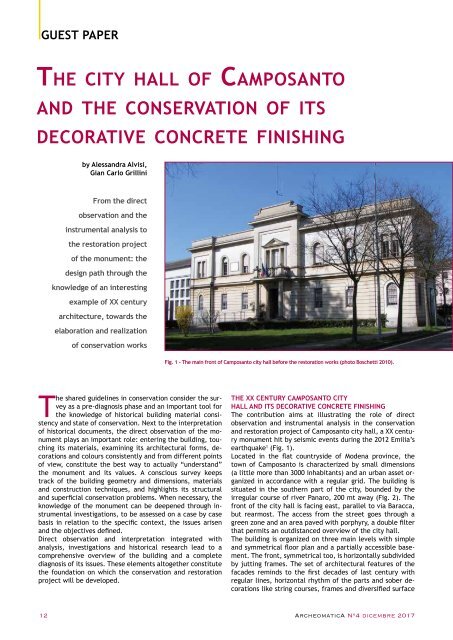You also want an ePaper? Increase the reach of your titles
YUMPU automatically turns print PDFs into web optimized ePapers that Google loves.
GUEST PAPER<br />
The city hall of Camposanto<br />
and the conservation of its<br />
decorative concrete finishing<br />
by Alessandra Alvisi,<br />
Gian Carlo Grillini<br />
From the direct<br />
observation and the<br />
instrumental analysis to<br />
the restoration project<br />
of the monument: the<br />
design path through the<br />
knowledge of an interesting<br />
example of XX century<br />
architecture, towards the<br />
elaboration and realization<br />
of conservation works<br />
Fig. 1 - The main front of Camposanto city hall before the restoration works (photo Boschetti 2010).<br />
The shared guidelines in conservation consider the survey<br />
as a pre-diagnosis phase and an important tool for<br />
the knowledge of historical building material consistency<br />
and state of conservation. Next to the interpretation<br />
of historical documents, the direct observation of the monument<br />
plays an important role: entering the building, touching<br />
its materials, examining its architectural forms, decorations<br />
and colours consistently and from different points<br />
of view, constitute the best way to actually “understand”<br />
the monument and its values. A conscious survey keeps<br />
track of the building geometry and dimensions, materials<br />
and construction techniques, and highlights its structural<br />
and superficial conservation problems. When necessary, the<br />
knowledge of the monument can be deepened through instrumental<br />
investigations, to be assessed on a case by case<br />
basis in relation to the specific context, the issues arisen<br />
and the objectives defined.<br />
Direct observation and interpretation integrated with<br />
analysis, investigations and historical research lead to a<br />
comprehensive overview of the building and a complete<br />
diagnosis of its issues. These elements altogether constitute<br />
the foundation on which the conservation and restoration<br />
project will be developed.<br />
THE XX CENTURY CAMPOSANTO CITY<br />
HALL AND ITS DECORATIVE CONCRETE FINISHING<br />
The contribution aims at illustrating the role of direct<br />
observation and instrumental analysis in the conservation<br />
and restoration project of Camposanto city hall, a XX century<br />
monument hit by seismic events during the 2012 Emilia’s<br />
earthquake 1 (Fig. 1).<br />
Located in the flat countryside of Modena province, the<br />
town of Camposanto is characterized by small dimensions<br />
(a little more than 3000 inhabitants) and an urban asset organized<br />
in accordance with a regular grid. The building is<br />
situated in the southern part of the city, bounded by the<br />
irregular course of river Panaro, 200 mt away (Fig. 2). The<br />
front of the city hall is facing east, parallel to via Baracca,<br />
but rearmost. The access from the street goes through a<br />
green zone and an area paved with porphyry, a double filter<br />
that permits an outdistanced overview of the city hall.<br />
The building is organized on three main levels with simple<br />
and symmetrical floor plan and a partially accessible basement.<br />
The front, symmetrical too, is horizontally subdivided<br />
by jutting frames. The set of architectural features of the<br />
facades reminds to the first decades of last century with<br />
regular lines, horizontal rhythm of the parts and sober decorations<br />
like string courses, frames and diversified surface<br />
12 ArcheomaticA N°4 dicembre <strong>2017</strong>


















